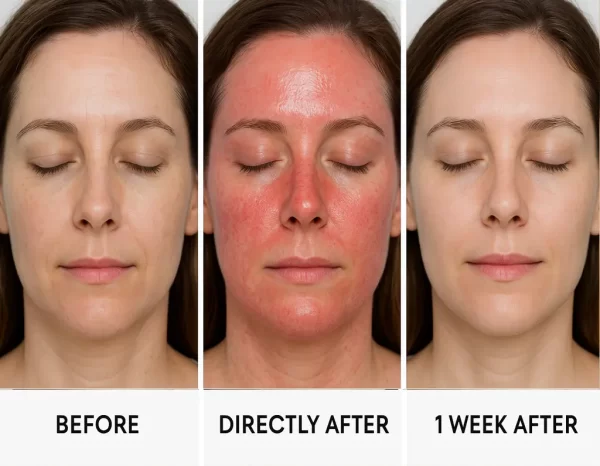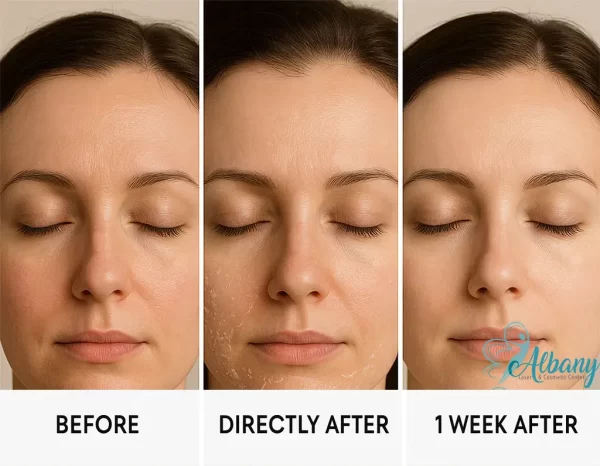Professional Chemical Peels Edmonton
Reveal brighter, clearer skin with a customized, medical-grade chemical peel at Albany Cosmetic & Laser Centre. Guided by Director, Dr. Kamal Alhallak (PhD, MBA), our team selects the right peel strength and acid blend (HydraFacial, TCA, Jessner) to refine texture, soften fine lines, clarify breakouts, and even out tone—with minimal downtime and a precise post-care plan.


Chemical Peel At-A-Glance
Cost & Pricing
What To Expect
Mechanism of Action
Chemical peels exfoliate skin through controlled chemical-induced shedding, promoting collagen production, removing damaged skin cells, and revealing healthier, smoother, rejuvenated skin beneath.
Benefits & Results
Peels visibly reduce acne scars, hyperpigmentation, wrinkles, and uneven texture; revealing smoother, brighter skin with improved tone, clarity, and youthful appearance over sessions.
Post-Treatment Care
Common side effects include redness, peeling, sensitivity, and mild irritation lasting several days. Downtime varies with peel depth, typically 3–7 days recovery.
Side Effects & Downtime
Mild to moderate discomfort experienced, including stinging, tingling, or slight burning sensation during application; generally well-tolerated and manageable with minimal pain overall.
Chemical Peel Types and Cost in Edmonton
- Superficial Peels: Mild acids (AHA/BHA) gently exfoliate the outer layer to improve minor discoloration and roughness. At our clinic, this includes the HydraFacial® Glycolic step (7%, 15%, 30%) for controlled, no-downtime renewal. Cost: CA$199 (Signature), CA$300 (Deluxe), CA$325 (Platinum).
- Medium Peels: Stronger acids (e.g., glycolic/TCA blends) reach deeper to refine fine lines, smooth texture, and fade age spots. Jessner Peel (lactic + salicylic + resorcinol) targets pigment, congestion, and texture, yielding light to medium-depth results; expect 2–5 days of flaking. Cost: CA$150–$300 per session.
- Deep Peels (TCA only): For select cases, higher-strength TCA addresses more pronounced wrinkles or scars and requires a longer recovery. We do not perform phenol peels. Pricing is provided after a physician assessment, based on the depth and treatment area.
Every peel is customized to your skin type (Fitzpatrick I–VI) and goals, with clear aftercare instructions for safe and predictable results.
Why Choose Albany Cosmetic & Laser Centre for Chemical Peels?
- Physician-directed care: Led by Dr. Kamal Alhallak (PhD, MBA), blending medical rigor with aesthetic precision.
- Personalized protocols: Fitzpatrick I–VI assessment to tailor acid, strength, layers, and contact time to your goals.
- Full-spectrum options: HydraFacial® Glycolic (7%, 15%, 30%), Jessner, and selective TCA when appropriate.
- Melanin-conscious safety: Prep and post-care designed to minimize PIH and support even results across skin tones.
- Comfort & hygiene: Medical-grade prep, precise timing, real-time endpoint monitoring, and controlled neutralization.
- Proven combinations: Strategic pairing with microneedling, IPL, and medical skincare for amplified outcomes.
- Visible, trackable results: Baseline photos, progress checks, and a home routine to maintain gains.
- Transparent pricing: Clear menu and package options that match plan and budget.
- Aftercare & follow-up: Written instructions, SPF/barrier support, and check-ins for safe healing.
- Edmonton convenience: Central location with easy online booking and flexible scheduling.
Ready to Refresh Your Skin?
Book a physician-directed chemical peel at Albany Cosmetic & Laser Centre in Edmonton. We’ll tailor HydraFacial® Glycolic (7%, 15%, 30%) or Jessner to your skin and schedule.
Frequently Asked Questions
What Is a Chemical Peel and How it works?
- A chemical peel removes compacted surface cells to brighten tone and smooth texture.
- Mechanism: lowered pH loosens desmosomes, boosts turnover, clears pores, stimulates collagen.
- Our options: HydraFacial Glycolic (7%, 15%, 30%) and classic Jessner.
- HydraFacial Glycolic integrates within HydraFacial for controlled exfoliation and minimal downtime.
- Feel: brief tingling or warmth; neutralized quickly and followed by hydrating serums.
- Results: fresher glow, refined pores; slight flaking up to two days at higher strengths.
- Jessner blends lactic, salicylic, and resorcinol; light–medium depth targeting texture, pigment, and congestion.
- Downtime: stinging, occasional frosting, two–five days of shedding; follow SPF, moisturize, avoid heat and actives.
- Typical plan: three to six sessions every two to four weeks, customized after Fitzpatrick assessment and skin goals.
- Suitable across Skin Types I–VI.
How should I prepare for a chemical peel?
- Complete a brief medical review: medications, allergies, pregnancy, cold sore history, and current skincare.
- Pause retinoids, exfoliating acids, benzoyl peroxide, scrubs for 5–7 days.
- Avoid waxing, threading, depilatories, microdermabrasion, lasers on the treatment area.
- Limit sun exposure; no tanning; wear broad spectrum SPF 30+ daily for two weeks.
- Stop photosensitizing meds if approved by prescriber; disclose antibiotics, isotretinoin, St. John’s wort.
- Consider pre-treating higher Fitzpatrick types with pigment-balancing skincare per clinician guidance.
- If prone to herpes simplex, ask about antiviral prophylaxis before medium peels.
- Hydrate well; skip alcohol the night before; arrive makeup-free and freshly cleansed.
- Do not shave the area 24 hours prior; bring your skincare products list.
- Reschedule if active breakouts, wounds, sunburns, or recent procedures; follow customized instructions.
How often should I get a chemical peel?
- The frequency with which you receive facial peels depends on your individual goals, including your age and lifestyle factors.
- Generally speaking, light treatments, such as mild glycolic peels, can be performed every 1-2 weeks. In contrast, deeper treatments, like TCA or phenol, may require at least 1-2 months between additional sessions for adequate recovery time.
- It is essential to consult with an experienced skincare professional who can offer personalized advice on the type of peel that is most suitable for your specific needs, as well as the optimal frequency for achieving the best results.
What are the side effects of a chemical peel?
- It’s common to see redness, similar to a sunburn, which can last a few days. Some people might also experience swelling or blistering, especially after deeper peels. A few days post-treatment, you may notice your skin starting to peel or flake, and this can continue for up to a week.
- Changes in skin color, either becoming darker or lighter, can occur, and in some cases, might be permanent. There’s a small risk of infection or scarring, particularly if the peel is not done correctly or if you do not follow post-treatment care recommendations.
- Moreover, some individuals may also develop cold sores if they have a history of herpes. After the procedure, your skin may become more sensitive to the sun, making it vital to wear sunscreen daily.
Who should avoid a chemical peel?
- Active skin infection, open wounds, dermatitis flare, or sunburn on the area.
- Recent isotretinoin use (within 6–12 months) or poor wound-healing history.
- Keloid/hypertrophic scarring tendency; consider gentler options or test spots.
- Pregnant or breastfeeding: avoid medium peels; very superficial only with physician clearance.
- Allergy to peel components (e.g., salicylates/aspirin, resorcinol, glycolic, TCA).
- Active cold sores (HSV); defer until treated; consider antiviral prophylaxis if prone.
- Recent procedures: waxing/threading, depilatories, lasers, microneedling, or aggressive exfoliants.
- Heavy recent tanning or inconsistent SPF use (higher PIH risk).
- Photosensitizing meds (some antibiotics, St. John’s wort) or recent chemo/radiation—need clearance.
- Inability to follow aftercare or unrealistic downtime expectations—alternate treatments may be recommended.
What is proper aftercare after a chemical peel?
- Keep skin moisturized with fragrance free cream; reapply as dryness and tightness arise.
- Use broad spectrum SPF 30+ every morning; reapply every two hours when outdoors.
- Cleanse gently with lukewarm water and a mild, nonfoaming cleanser; pat, do not rub.
- Do not pick, peel, or scrub flaking skin; allow shedding to occur naturally.
- Avoid heat, saunas, hot yoga, strenuous exercise, and sweating for 48 to 72 hours.
- Pause retinoids, acids, scrubs, benzoyl peroxide, and hair removal for one week.
- Sleep elevated the first night; change to a clean pillowcase.
- Makeup: mineral or noncomedogenic only after peeling subsides; skip if stinging.
- Expect tingling and light flaking; call us for severe redness, blistering, or swelling.
- Follow your plan; schedule follow up; wear hats.
Facial peel preparation, treatment day care, and aftercare
Read our privacy policy here